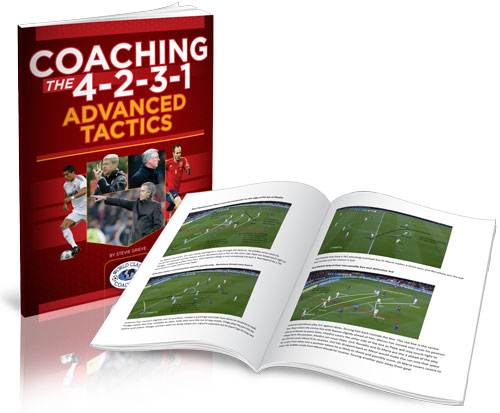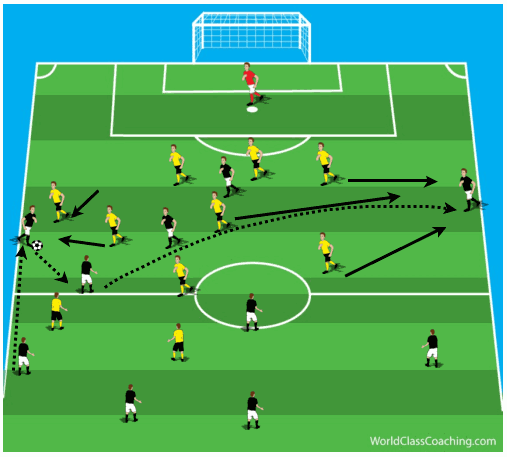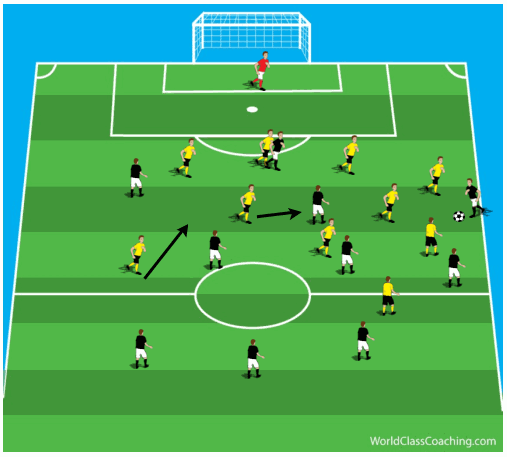One of the factors that always kept me from moving away from the 4-4-2 was a concern for how to cover the wide areas using a 4-3-3 or a 4-2-3-1. Once I understood how to teach my players to recognize cues and cover for each other I saw how the systems could be used to teach players more about the game. Requiring them to make decisions is the best way for them to learn rather than just putting them in a formation that has strictly defined roles where they just, 'do their job'.
Stevie Grieve's latest book, Coaching the 4-2-3-1 Advanced Tactics, does a great job of explaining how to teach your players to cover these areas. Below is a brief excerpt from his book.
Defending on the sides in a 4-2-3-1
In the 4-2-3-1 formation, there are two players who can defend on the sides; the full back and wide midfielder, but with the benefit of the 3rd central midfielder, one of them can shift over and have 3 players close down the space on the side, or allow extra cover when the winger is too far ahead of the ball.
The flexibility of the 4-2-3-1 allows different players to leave their designated position to cover other players who have left position to help team mates who are within pressing distance. The flexibility also allows slight, temporary formation changes to occur, for example, below is an example of changing to a 4-3-3 as the attacking midfielders don’t chase back to help the full backs, so the central attacking midfielder will drop in as the near side central midfielder will move over to press the ball.
[wpsharely id="6889"][/wpsharely]This can help conserve the energy of players who need to be more dynamic and decisive close to the goal, or players who are needed to carry possession 40-60 yards in attacking scenario’s in situations such as a 3v4 on the counter attack when the defence are dropping off, not chasing back allows and has allowed players such as Ronaldinho, Cristiano Ronaldo, Lionel Messi and Robert Pires become such effective attacking players as they have more energy to be effective in the attacking phases of play.
The ball is switched from one side to the far side, almost like the Xabi Alonso pattern of play for Real Madrid. In a more likely scenario for less talented players, the ball would be transferred again inside to be passed to the far side. As the ball is passed wide to the weak side of the defense, the far side full back and far side attacking midfielder would move across and press the ball. The midfield and defense would move over to adjust to the new position of the ball, taking care to cover the zones but to mark players as you move into new positions.
Scenario 1 – the full back, central midfielder and winger can all cover the distance to press the ball – 1v3 on the side with no overlap from the full back
As the ball is switched to the far side, the priority for the back 4 is to get into positions and mark the striker, while the central midfielders need to firstly get into position centrally and allow the midfield to become a 4-4-1-1 formation with the far side attacking midfielder dropping deep into a wide midfield position as the central midfielder pushed across to mark the opponent who is in the space between the lines and central midfielders.
As the player on the ball will likely try to attack the full back 1v1, there are two main options here – the central midfielder presses the ball as the full back drops off to cover the space down the dribbling line, or the full back presses and shows the winger inside to his supporting central midfielder. The near side attacking midfielder should try to block the pass back to the full back and stop easy passes to keep possession if the space to attack is covered.
Some teams such as Barcelona are more effective when passing back to move the ball diagonally across the defense and midfield so although stopping forward passes is obviously a priority, stopping passes back that result in easy ball retention are just as important.
Many more scenarios are discussed in the book that you can learn more about here.
Have a Great Day,
Tom





